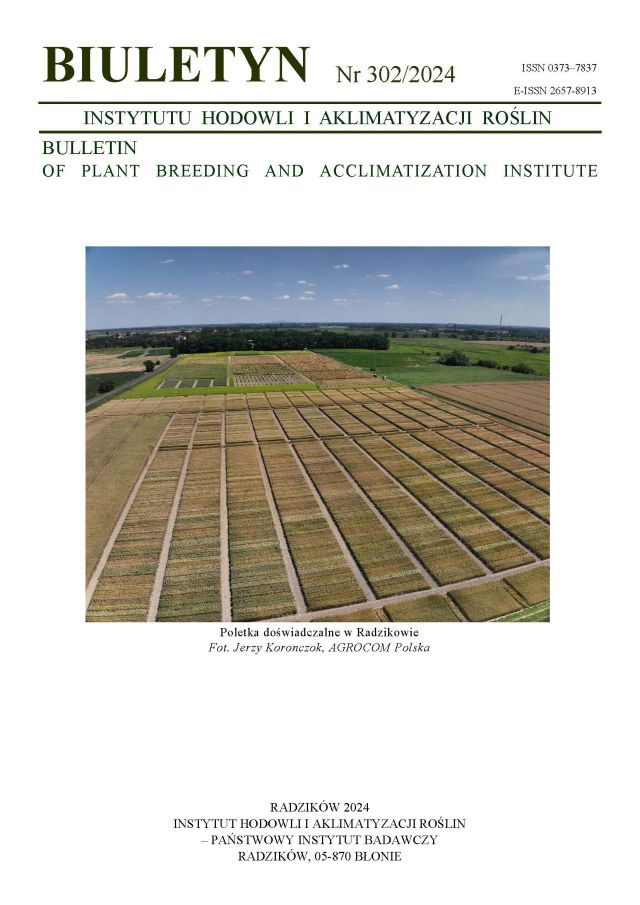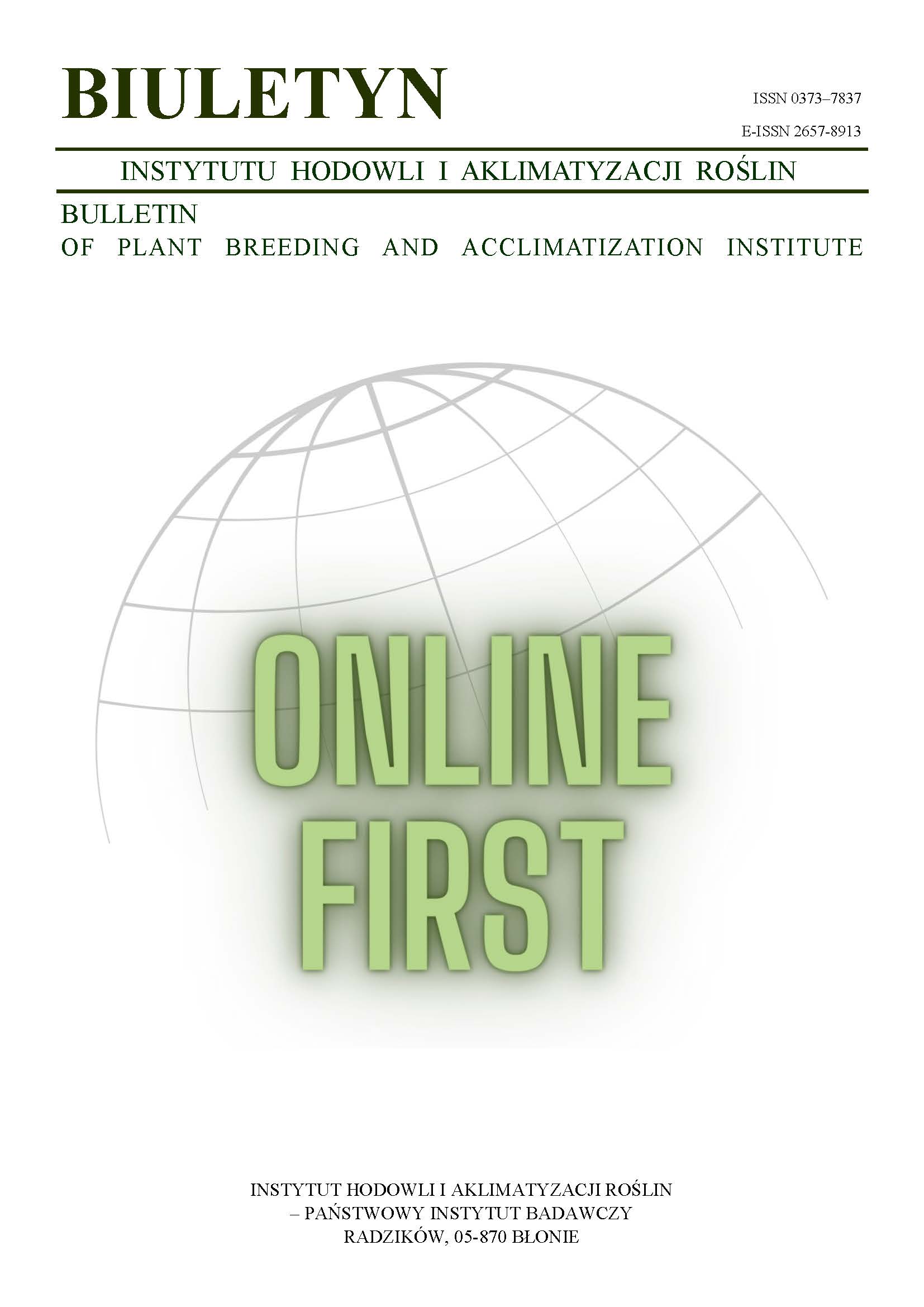Molekularne podstawy adaptacji kukurydzy do różnych warunków klimatycznych
Alicja Sobkowiak
a.sobkowiak@ihar.edu.plZakład Biochemii i Fizjologii Roślin, IHAR — PIB, Radzików (Poland)
Jarosław Szczepanik
Zakład Ekofizjologii Molekularnej Roślin, Uniwersytet Warszawski, Warszawa (Poland)
Paweł Sowiński
Zakład Ekofizjologii Molekularnej Roślin, Uniwersytet Warszawski, Warszawa (Poland)
Abstrakt
Znaczenie kukurydzy wzrasta w ostatnich latach, o czym decyduje głównie łatwość jej uprawy, wysokie plonowanie oraz wszechstronność zastosowań tego gatunku. Wiąże się to ze wzrostem areału upraw tej rośliny. Ze względu na pochodzenie, uprawa kukurydzy w strefie klimatu umiarkowanego wiąże się z uzyskaniem materiałów hodowlanych przystosowanych do szeregu czynników abiotycznych, takich jak odmienny fotoperiod, okresowe susze i niska temperatura. Molekularne podłoże adaptacji kukurydzy do omawianych czynników jest słabo poznane. Wypełnienie tej luki jest warunkiem dalszego postępu hodowlanego, szczególnie w obliczu przewidywanych zmian klimatu.
Słowa kluczowe:
adaptacja, chłód, dobór sztuczny, kukurydza, susza, zmiany klimatuBibliografia
Agarwal P. K., Agarwal P, Reddy M. K., Sopory S. K. 2006. Role of DREB transcription factors in abiotic and biotic stress tolerance in plants. Plant Cell Rep. 25: 1263 — 1274.
Google Scholar
Blackie M J. 1994. Maize productivity for the 21st century: the African challenge. Outlook Agric. 23: 189 — 195.
Google Scholar
Bratton M. 1986. Farmer organizations and food production in Zimbabwe. World Develop. 14: 367 — 384.
Google Scholar
Buckler E. S., Holland J. B., Bradbury P. J., Acharya C., Brown P. J., Browne C., Erso E, Flint-Garcia S., Garcia A., Glaubitz J., Goodman M., Harjes C., Guill1 K., Kroon D.E, Larsson S., Lepak N.K., Li H., Mitchel S., Pressoir G., Peiffer J., Rosas O., Rocheford T. R., Romay C. M., Romero S., Salvo S., Villeda S., da Silva H. S., Sun Q., Tian F., Upadyayula N., Ware D., Yates H., Yu J., Zhang Z., Kresovich S., McMullen M. D. 2009. The genetic architecture of maize flowering time. Science 325: 714 — 718.
Google Scholar
Chapman G. P. 1996. The biology of grasses. CAB International, Sydney.
Google Scholar
Coles N. D., McMullen M. D., Balint — Kurti P. J., Pratt R. C , Holland J. B. 2010. Genetic control of photoperiod sensitivity in maize revealed by joint multiple population analysis. Genetics 184: 799 — 812.
Google Scholar
Driscoll SE, Prins A, Olmos E, Kunert KJ, Foyer CH. 2006. Specification of adaxial and abaxial stomata, epidermal structure and photosynthesis to CO2 enrichment in maize leaves. J. Exp. Bot. 51: 381 — 390.
Google Scholar
Ducrocq S., Madur D., Veyrieras J-B. , Camus-Kulandaivelu L., Kloiber-Maitz M., Presterl T., Ouzunova M., Manicacci D., Charcosset A. 2008. Key impact of Vgt1 on flowering time adaptation in maize: evidence from association mapping and ecogeographical information. Genetics 18: 2433 — 243.
Google Scholar
Edwards E. J., Still E. J. 2008. Climate, phylogeny and the ecological distribution of C4 grasses. Ecol. Let. 11: 266 — 276.
Google Scholar
Ehleringer J. R., Cerling, T. E., Helliker B. R. 1997. C4 photosynthesis, atmospheric CO2 and climate. Oecologia 112: 285 — 299.
Google Scholar
Finan J. J. 1948. Maize in the great herbals. Ann. Mo. Bot. Gard. 35: 149 — 165.
Google Scholar
Fracheboud Y., Jompuk C., Ribaud M. J., Stamp P, Leipner J. 2004. Genetic analysis of cold — tolerance of photosynthesis in maize. Plant Mol. Biol. 56: 241 — 253.
Google Scholar
Franks P.J., Beerling D. J. 2009. Maximum leaf conductance driven by CO2 effects on stomatal size and density over geologic time. PNAS 106: 10343 — 10347.
Google Scholar
Ghannoum O. von Caemmerer S. Ziska L. H. Conroy J. P. 2000. The growth response of C4 plants to rising atmospheric CO2 partial pressure: a reassessment. Plant, Cell Environ. Vol. 23: 931 — 942.
Google Scholar
Goodman M. M. 2005. Broadening the U.S. maize germplasm base. Maydica 50: 203 — 214.
Google Scholar
Guo J., Su G., Zhang J., Wang G. 2008. Genetic analysis and QTL mapping of maize yield and associate agronomic traits under semi — arid land condition. Afr. J. Biotech. 7: 1829 — 1838.
Google Scholar
Kenny G. J., Harrison P. A. 1992. Thermal and moisture limits of grain maize in Europe: model testing and sensitivity to climate change. Clim. Res. 2: 113 — 129.
Google Scholar
Knapp A. K., Fay P.A., Blair J. M., Collins S. L., Smith M. D., Carlisle J. D., Harper C. W., Danner B. T., Lett M. S., McCarron J. K. 2002. Rainfall variability, carbon cycling, and plant species diversity in a mesic grassland. Nature 298: 2202 — 2205.
Google Scholar
Koski V. 1996. Breeding plants in case of global warming. Euphytica 92: 235 — 239.
Google Scholar
Labate J. A., Lamkey K. R., Mitchell S. E., Kresovich S., Sullivan H., Smith J. S. C. 2003. Molecular and historical aspects of Corn Belt dent diversity. Crop Sci. 43: 80 — 91.
Google Scholar
Leakey A. D. B., Ainsworth E .A., Bernacchi C. J., Rogers A., Long S. P., Ort D. R. 2009. Elevated CO2 effects on plant carbon, nitrogen, and water relations: six important lessons from FACE. J. Exp. Bot. 60: 2859 — 2876.
Google Scholar
Lisiecki L. E., Raymo ME. 2005. A Pliocene — Pleistocene stack of 57 globally distributed benthic δ18O records. Paleoceanography 20: PA1003.
Google Scholar
Liu Y., Subhash C., Yan J., Song C., , Zhao J., Li J. 2011. Maize leaf temperature responses to drought: Thermal imaging and quantitative trait loci (QTL) mapping. Environ. Exp. Bot. 71: 158 — 165.
Google Scholar
Masle J, Gilmore SR, Farquhar GD. 2005. The ERECTA gene regulates plant transpiration efficiency in Arabidopsis. Nature 436: 866 — 870.
Google Scholar
Mayewski P. A., Rohling E. E., Stager J. C., Wibjörn K., Maasch K. A. Meeker L. D., Meyerson E. A., Gasse F., van Kreveld S., Holmgren K., Lee-Thorp J., Rosqvist G., Rack F., Staubwasser M., Schneider R. R., Steig E. J. . 2004. Holocene climate variability. Quaternary Res. 62: 243 — 255.
Google Scholar
Moose S.P, Dudley J. W., Rocheford T. R. 2004. Maize selection passes the century mark: a unique resource for 21st century genomics. Trends Plant Sci. 9: 358 — 364.
Google Scholar
Ortiz R., Taba S., Chavez V. H., Mezzalama M., Xu Y., Yan J., Crouch J. H. 2010. Conserving and genetic resources as global public goods– a perspective from CIMMYT. Crop Sci. 50: 13 — 28.
Google Scholar
Petit J. R., Jouzel J., Raynaud D., Barkov N. I., Barnola J.-M., Basile I., Bender M., Chappellaz J., Davis M., Delaygue G., Delmotte M., Kotlyakov V.M., Legrand M., Lipenkov V.Y., Lorius C., Pepin L., Ritz C., Saltzman E., Stievenard M. 1999. Climate and atmospheric history of the past 420,000 years from the Vostok ice core, Antarctica. Nature 399: 429 — 436.
Google Scholar
Prasanna B. M. 2012. Diversity in global maize germplasm: characterization and utilization. J. Biosci. 37: 843 — 855.
Google Scholar
Prasanna B. M., Vasal S. K., Kassahun B., Singh N. N. 2001. Quality protein maize. Current Science 81: 1308 — 1319.
Google Scholar
Sage R. F., Christin P. A., Edwards E. J. 2011. The C4 plant lineages of planet Earth. J. Exp. Bot. 62: 3155 —3169.
Google Scholar
Sage R. F., Kubien D. S. 2003. Quo vadis C4? An ecophysiological perspective on global change and the future of C4 plants. Photosynth. Res. 77: 209 — 225.
Google Scholar
Salvi S., Castelletti S., Tuberosa R. 2009. An updated consensus map on flowering time QTLs in maize. Maydica 54: 501 — 512.
Google Scholar
Salvi S., Sponza G., Morgante M., Tomes D., Niu X., Fengler K. A., Meeley R., Ananiev E. V., Svitashev S., Bruggemann E., Li B., Hainey C. F., Radovic S., Zaina G., Rafalski J. A., Tingey S. V., Miao G.-H., Phillips R. L., Tuberosa R. 2007. Conserved non coding genomic sequences associated with a flowering — time quantitative trait locus in maize PNAS 104: 11376 — 11381.
Google Scholar
Sobkowiak A. 2012. Reakcje kukurydzy na chłód umiarkowany na poziomie transkryptomicznym i proteomicznym. Rozprawa doktorska. IHAR PIB, Radzików.
Google Scholar
Sowiński P. 2000 a. Wrażliwość kukurydzy na chłód. Cz. 1. Wzrost, rozwój, fotosynteza. Biul. IHAR 214: 3 — 16.
Google Scholar
Sowiński P. 2000 b. Wrażliwość kukurydzy na chłód. Cz. 2. System korzeniowy, regulacja funkcjonowania rośliny, perspektywy hodowli. Biul. IHAR. 214: 17 — 29.
Google Scholar
Stamp P. 1984. Chilling tolerance of young plants demonstrated on the example of maize (Zea mays L.). In: Advances in Agronomy and Crop Science no 7, G. Geisler (ed.), Berlin, Parey: 83.
Google Scholar
Tenaillon M. I., Charcosset A. 2011. A European perspective on maize history. C.R. Biologies 334: 221 — 228.
Google Scholar
Tian F., Stevens N. M., Buckler E. S. 2009. Tracking footprints of maize domestication and evidence for a massive selective sweep on chromosome 10. PNAS 106: 9979 — 9986.
Google Scholar
Tracy W. F., Goldman I. L., Tiefenthaler A. E., Schaber M. A. 2004. Trends in productivity of U.S. crops and long- term selection. In: Janick J. (ed.). Plant Breeding Reviews. Long -term selection: Crops, animals, and bacteria. Vol. 24 (2). John Wiley & Sons. Oxford.
Google Scholar
Troyer A. F. 2004. Background of U.S. Hybrid corn: II. Breeding, climate and food. Crop Sci. 44: 370 — 380.
Google Scholar
Tuberosa R., Salvi S., Sanguineti M.C., Landi P., Maccaferri M., Conti S. 2002. Mapping QTLs regulating morpho-physiological traits and yield: Case studies, shortcomings and perspectives in drought — stressed maize. Annals Bot. 89: 941 — 963.
Google Scholar
Ureta C., Martinez-Meyer E., Perales H. R., Alvarez-Buylla E. R. 2012. Projecting the effects of climate change on the distribution of maize races and their wild relatives in Mexico Global Change Biol. 18: 1073 — 1082.
Google Scholar
Wang C. L, Cheng F. F., Sun Z. H., Tang J. H., Wu L. C., Ku L. X., Chen Y. H. 2008. Genetic analysis of photoperiod sensitivity in a tropical by temperate maize recombinant inbred population using molecular markers. Theor. Appl. Genet. 117: 1129 — 1139.
Google Scholar
Wasilewski M. 2005. Udomowienie roślin w Nowym Świecie. Wiad. Bot. 49: 19 — 37.
Google Scholar
Autorzy
Alicja Sobkowiaka.sobkowiak@ihar.edu.pl
Zakład Biochemii i Fizjologii Roślin, IHAR — PIB, Radzików Poland
Autorzy
Jarosław SzczepanikZakład Ekofizjologii Molekularnej Roślin, Uniwersytet Warszawski, Warszawa Poland
Autorzy
Paweł SowińskiZakład Ekofizjologii Molekularnej Roślin, Uniwersytet Warszawski, Warszawa Poland
Statystyki
Abstract views: 329PDF downloads: 119
Licencja
Prawa autorskie (c) 2013 Alicja Sobkowiak, Jarosław Szczepanik, Paweł Sowiński

Utwór dostępny jest na licencji Creative Commons Uznanie autorstwa – Na tych samych warunkach 4.0 Miedzynarodowe.
Z chwilą przekazania artykułu, Autorzy udzielają Wydawcy niewyłącznej i nieodpłatnej licencji na korzystanie z artykułu przez czas nieokreślony na terytorium całego świata na następujących polach eksploatacji:
- Wytwarzanie i zwielokrotnianie określoną techniką egzemplarzy artykułu, w tym techniką drukarską oraz techniką cyfrową.
- Wprowadzanie do obrotu, użyczenie lub najem oryginału albo egzemplarzy artykułu.
- Publiczne wykonanie, wystawienie, wyświetlenie, odtworzenie oraz nadawanie i reemitowanie, a także publiczne udostępnianie artykułu w taki sposób, aby każdy mógł mieć do niego dostęp w miejscu i w czasie przez siebie wybranym.
- Włączenie artykułu w skład utworu zbiorowego.
- Wprowadzanie artykułu w postaci elektronicznej na platformy elektroniczne lub inne wprowadzanie artykułu w postaci elektronicznej do Internetu, lub innej sieci.
- Rozpowszechnianie artykułu w postaci elektronicznej w internecie lub innej sieci, w pracy zbiorowej jak również samodzielnie.
- Udostępnianie artykułu w wersji elektronicznej w taki sposób, by każdy mógł mieć do niego dostęp w miejscu i czasie przez siebie wybranym, w szczególności za pośrednictwem Internetu.
Autorzy poprzez przesłanie wniosku o publikację:
- Wyrażają zgodę na publikację artykułu w czasopiśmie,
- Wyrażają zgodę na nadanie publikacji DOI (Digital Object Identifier),
- Zobowiązują się do przestrzegania kodeksu etycznego wydawnictwa zgodnego z wytycznymi Komitetu do spraw Etyki Publikacyjnej COPE (ang. Committee on Publication Ethics), (http://ihar.edu.pl/biblioteka_i_wydawnictwa.php),
- Wyrażają zgodę na udostępniane artykułu w formie elektronicznej na mocy licencji CC BY-SA 4.0, w otwartym dostępie (open access),
- Wyrażają zgodę na wysyłanie metadanych artykułu do komercyjnych i niekomercyjnych baz danych indeksujących czasopisma.
Inne teksty tego samego autora
- Alicja Sobkowiak, Jarosław Szczepanik, Paweł Sowiński, Molekularne podłoże udomowienia kukurydzy , Biuletyn Instytutu Hodowli i Aklimatyzacji Roślin: Nr 267 (2013): Wydanie regularne














